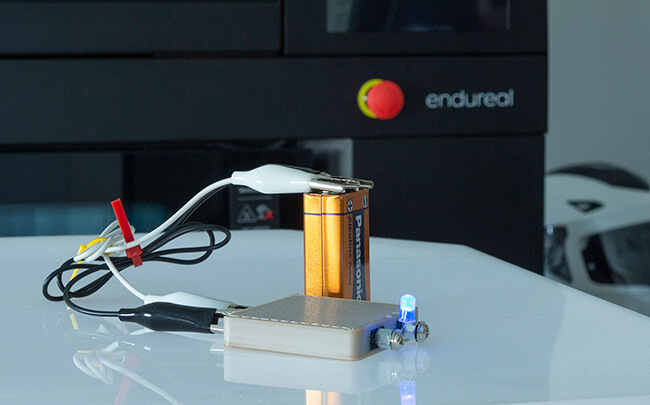Polish 3D printer manufacturer Zortrax has partnered with the European Space Agency (ESA) to fabricate experimental parts using two different blends of PEEK filament.
Leveraging its Endureal dual-extrusion system, Zortrax has been able to combine standard PEEK with an ESA conductive variant, to create proof-of-concept models that are capable of data and electricity transfer. The company has created its new class of amalgamated polymer with the stated aim of addressing the growing need for high-performance composite components in the aerospace sector.
“This [technology] will make our printer a powerful tool in the hands of engineers and designers working for high end and demanding applications like automotive, aerospace and space,” said Rafał Tomasiak, CEO of Zortrax. “We also expect groundbreaking solutions developed in projects like this one to quickly trickle down to our production level 3D printers.”
“The technology we are developing opens up a clear path to use the Zortrax Endureal for 3D printing smart components with built-in electrical circuits.”
Zortrax’s newly-merged-PEEK polymers
The breakthrough from Zortrax follows almost a year of R&D from the firm, which has seen it experiment with different formulations of PEEK polymers to identify the blend which showed the most ideal behaviors. Zortrax’s self-proclaimed “major milestone,” has resulted from a collaboration with the ESA, which developed an experimental conductive PEEK for the research program.
Combining the ESA’s pilot material with pure PEEK allowed Zortrax to create a stable, electrically-conductive combined polymer, which it has used to fabricate several cohesive models with data transfer features. In future, the conductivity of the merged polymers could be deployed to produce multifunctional parts that perform the role of directing electrical signals, as well as being vital to structural integrity.
“Reducing weight is always one of the key design goals in aerospace engineering and it can be done by building parts which serve multiple purposes at once,” explained Michał Siemaszko, Head of R&D at Zortrax. “This way, the structural parts can at the same time perform electricity or data transfer functions without weight penalty incurred for additional wires.”
Zortrax’s prototypes have opened a new development path for the firm, to create 3D printed parts with embedded electronics, while maintaining the inherent strength benefits of PEEK materials. In order to make sure that all its customers benefit from its R&D breakthrough, the company is already rolling out all the changes that it made to its machine, to all of its commercial systems.

The Endureal and LPD 3D printing technology
Zortrax introduced its Endureal line of Fused Filament Fabrication (FFF) 3D printers at TCT Show 2019, as a large-format dual-extrusion system which has specifically been optimized for printing with PEEK. The Endureal represents the third generation of the firm’s industrial LPD Plus machines, which Zortrax claims are capable of printing polymers with properties that are “comparable to metal alloys.”
In the case of the Endureal system, the company’s proprietary Layer Plastic Deposition (LPD) technology is combined with a dual-extrusion system, to 3D print high-temperature polymers with soluble support structures. Normally these supports are made out of other materials, but in Zortrax’s latest research, they were also constructed using PEEK, albeit a charged-up variant.
The company’s engineering team has also performed a few tweaks on its existing system, which it’s currently rolling-out to customers. By increasing the rigidity of the printer’s extrusion system, the team were able to achieve greater dimensional accuracy, while other changes enabled the Endureal to reach higher operating temperatures.
These upgrades have seen the 3D printer’s maximum extrusion temperature rise from 420oC to 480oC, leading to reduced warping and shrinkage, while printing with high performance materials. According to Tomasiak, Zortrax’s enhanced Endureal system combined with its new polymer blend, could enable the production of a new generation of 3D printed conductive parts.
“The technology we are developing opens up a clear path to use the Zortrax Endureal for 3D printing smart components while retaining excellent thermal and mechanical properties of PEEK,” said Tomasiak. “Imagine casting a solid steel slab that also works as a USB connector. That’s what the Endureal can do with high-performance polymers.”
Striving for PEEK performance
PEEK is a high-performance thermoplastic with a unique combination of chemical resistance and durability qualities, and this has seen it utilized within the demanding aerospace sector, as well as the production of medical parts.
German chemical company Evonik introduced its Vestakeep i4 3DF implant grade PEEK filament earlier this year, which has gained approval for surgical implant applications. The polymer features high biocompatibility, biostability, and x-ray transparency, to enable its use in the medical field.
US-based medical 3D printing start-up FossiLabs, meanwhile, has launched 3D printed scaffolding structures using a porous PEEK material. The bone-like medical devices are designed to be used within implantable devices, to encourage their integration.
Elsewhere, the German medical 3D printing startup Kumovis, has released its healthcare-oriented R1 machine. The company’s inaugural printer has been optimized to produce patient-specific medical devices and prototypes, using performance plastics such as PEEK.
To stay up to date with the latest 3D printing news, don’t forget to subscribe to the 3D Printing Industry newsletter or follow us on Twitter or liking our page on Facebook.
Are you looking for a job in the additive manufacturing industry? Visit 3D Printing Jobs for a selection of roles in the industry.
Featured image shows Zortrax’s Endureal system, which it has used to 3D print its conductive PEEK blend. Photo via Zortrax.


